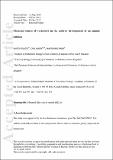Files in this item
Maternal source of variability in the embryo development of an annual killifish
Item metadata
| dc.contributor.author | Polačik, Matej | |
| dc.contributor.author | Smith, Carl | |
| dc.contributor.author | Reichard, Martin | |
| dc.date.accessioned | 2018-01-19T00:31:41Z | |
| dc.date.available | 2018-01-19T00:31:41Z | |
| dc.date.issued | 2017-04 | |
| dc.identifier | 248681286 | |
| dc.identifier | 2ccdf147-3b3c-4064-8a57-7f8995abd0f9 | |
| dc.identifier | 85010888126 | |
| dc.identifier | 000398682700006 | |
| dc.identifier.citation | Polačik , M , Smith , C & Reichard , M 2017 , ' Maternal source of variability in the embryo development of an annual killifish ' , Journal of Evolutionary Biology , vol. 30 , no. 4 , pp. 738-749 . https://doi.org/10.1111/jeb.13038 | en |
| dc.identifier.issn | 1420-9101 | |
| dc.identifier.other | Bibtex: urn:b1170263da10dcf371f9d2f72c054d3a | |
| dc.identifier.other | ORCID: /0000-0003-3285-0379/work/47136204 | |
| dc.identifier.uri | https://hdl.handle.net/10023/12515 | |
| dc.description | The study was supported by the Czech Science foundation, grant No. GA206/09/0815. | en |
| dc.description.abstract | Organisms inhabiting unpredictable environments often evolve diversified reproductive bet-hedging strategies, expressed as production of multiple offspring phenotypes, thereby avoiding complete reproductive failure. To cope with unpredictable rainfall, African annual killifish from temporary savannah pools lay drought-resistant eggs that vary widely in the duration of embryo development. We examined the sources of variability in the duration of individual embryo development, egg production and fertilization rate in Nothobranchius furzeri. Using a quantitative genetics approach (North Carolina Type II design) we found support for maternal effects rather than polyandrous mating as the primary source of the variability in the duration of embryo development. The number of previously laid eggs appeared to serve as an internal physiological cue initiating a shift from rapid to slow embryo developmental mode. In annual killifish extensive phenotypic variability in progeny traits is adaptive, as the conditions experienced by parents have limited relevance to the offspring generation. In contrast to genetic control, with high phenotypic expression and heritability, maternal control of traits under natural selection prevents standing genetic diversity from potentially detrimental effects of selection in fluctuating environments. | |
| dc.format.extent | 441373 | |
| dc.language.iso | eng | |
| dc.relation.ispartof | Journal of Evolutionary Biology | en |
| dc.subject | Genetic benefit | en |
| dc.subject | Good genes | en |
| dc.subject | Mating system | en |
| dc.subject | Diapause | en |
| dc.subject | Erratic rainfall | en |
| dc.subject | QH426 Genetics | en |
| dc.subject | QH301 Biology | en |
| dc.subject | DAS | en |
| dc.subject.lcc | QH426 | en |
| dc.subject.lcc | QH301 | en |
| dc.title | Maternal source of variability in the embryo development of an annual killifish | en |
| dc.type | Journal article | en |
| dc.contributor.institution | University of St Andrews. School of Biology | en |
| dc.contributor.institution | University of St Andrews. Marine Alliance for Science & Technology Scotland | en |
| dc.contributor.institution | University of St Andrews. Scottish Oceans Institute | en |
| dc.identifier.doi | 10.1111/jeb.13038 | |
| dc.description.status | Peer reviewed | en |
| dc.date.embargoedUntil | 2018-01-18 |
This item appears in the following Collection(s)
Items in the St Andrews Research Repository are protected by copyright, with all rights reserved, unless otherwise indicated.

